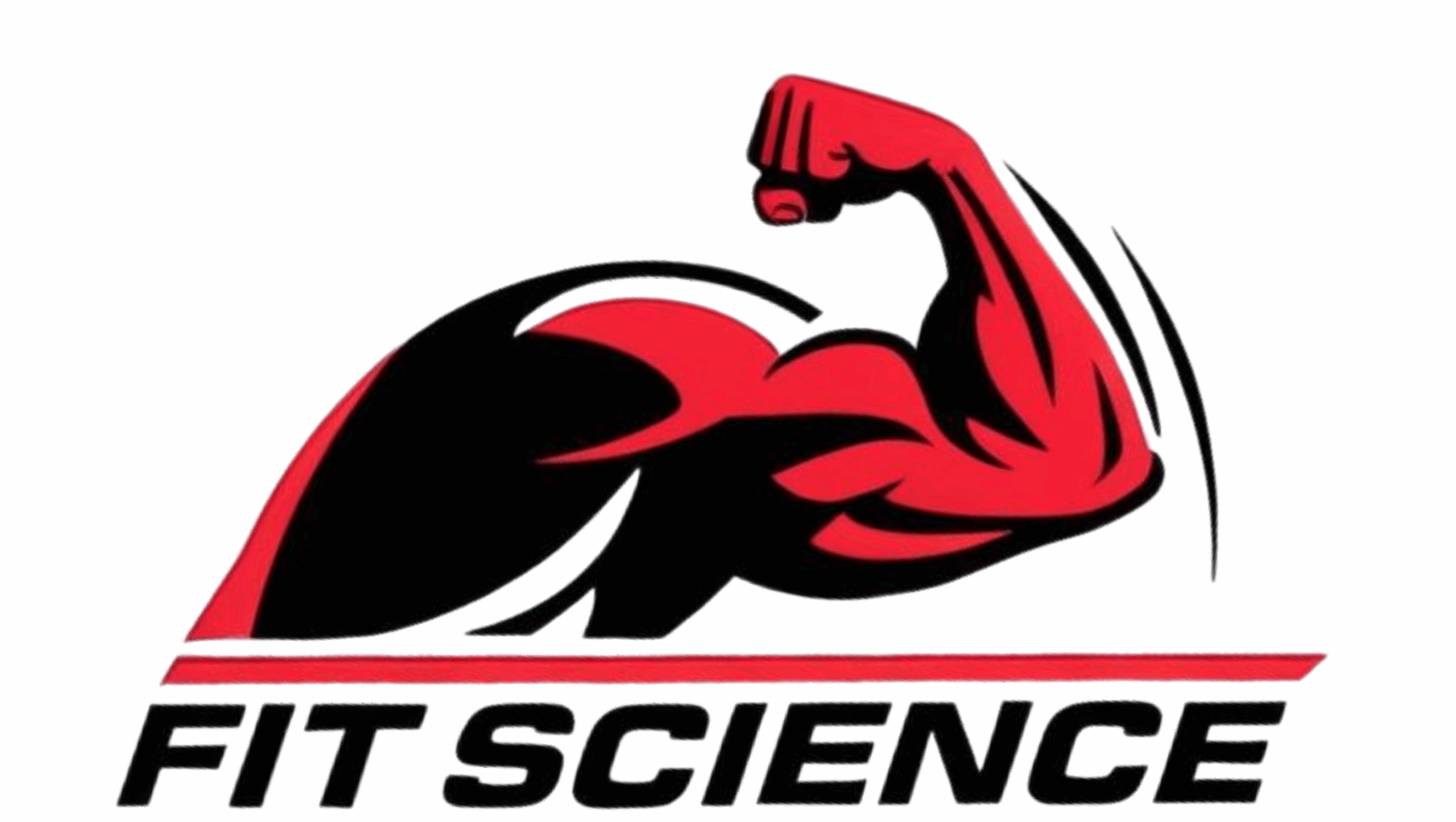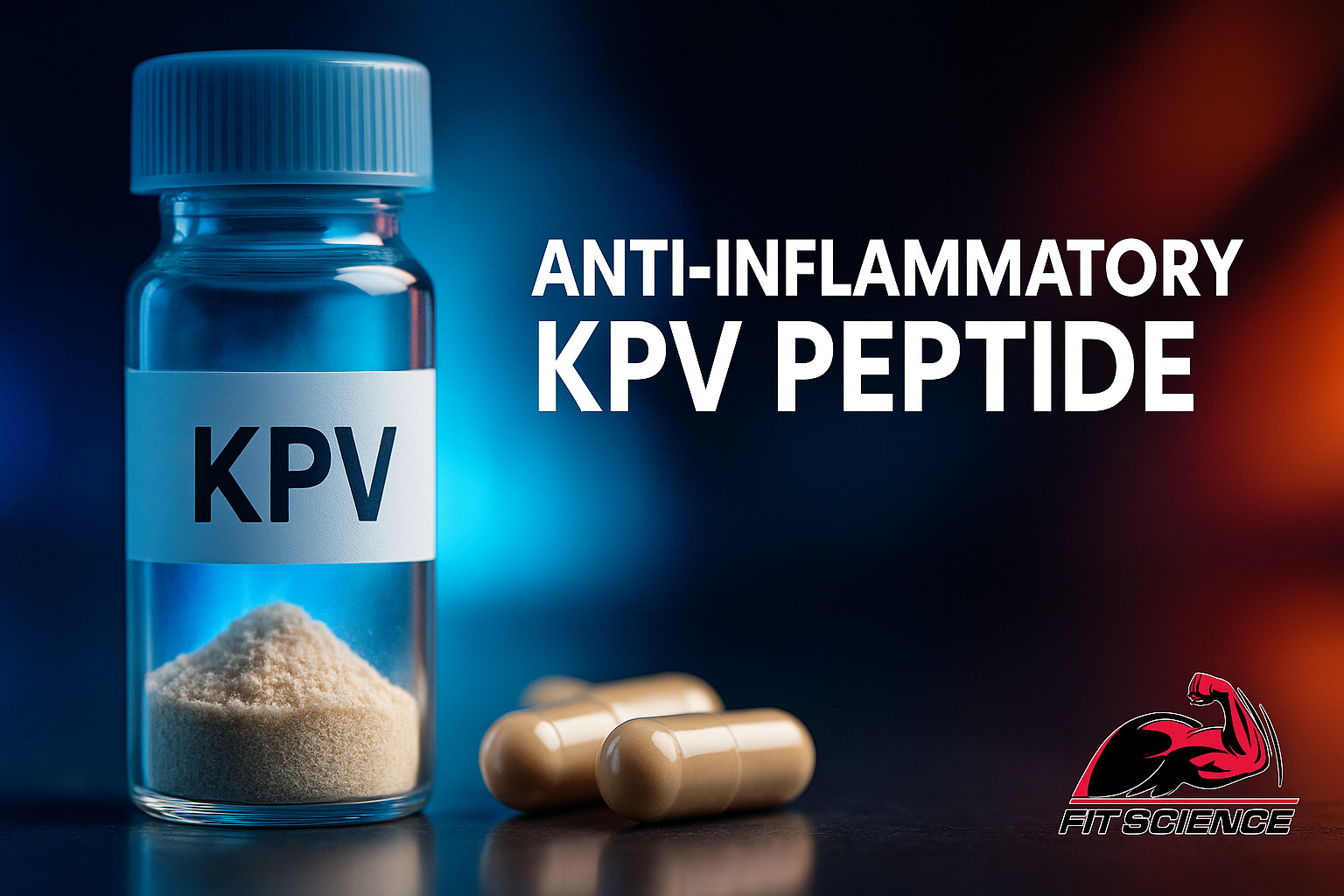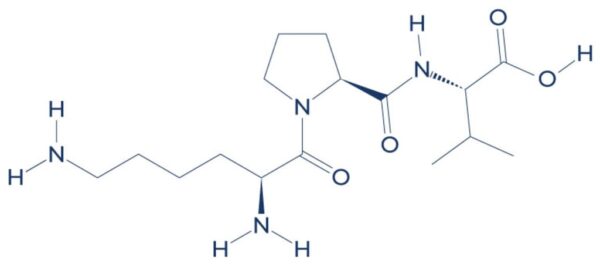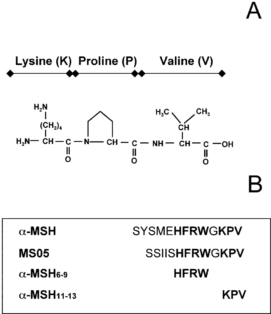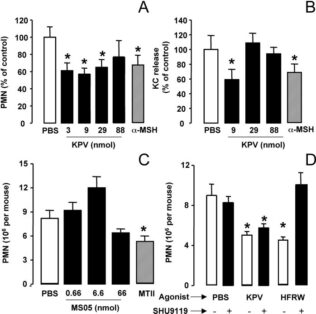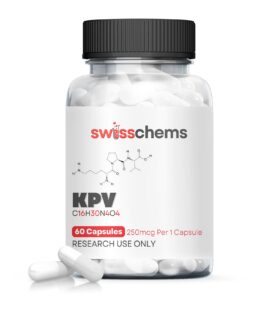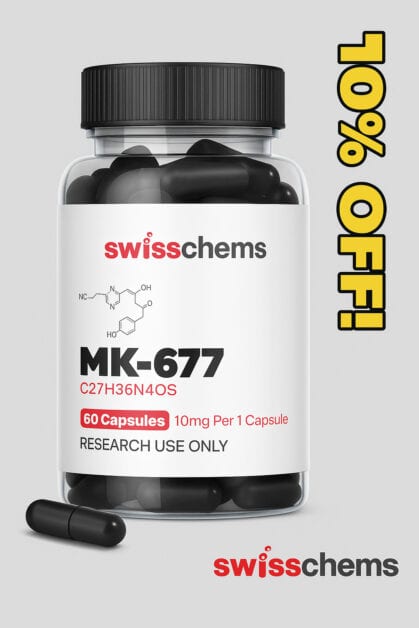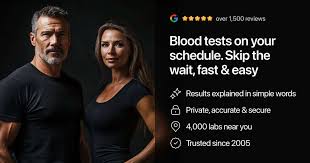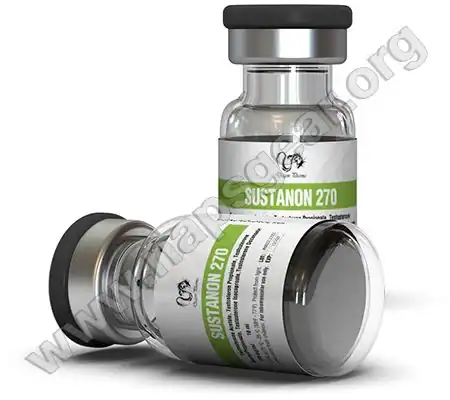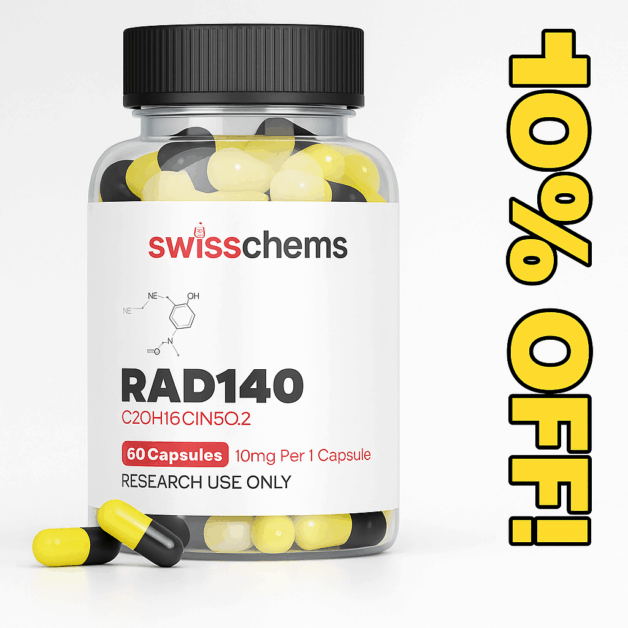Progress in bodybuilding rarely stalls because a lifter forgot how to squat. It stalls because recovery cannot keep up with training ambition. If inflammation lingers, if the gut rebels during high calorie bulks or during a hard cut, if connective tissue stays irritated, the engine never operates at peak output. Serious athletes solve these bottlenecks first because better recovery multiplies every minute in the gym.
KPV peptide the tripeptide Lysine Proline Valine that is derived from the larger alpha melanocyte stimulating hormone, is being explored for exactly these recovery bottlenecks. KPV peptide is not an anabolic signal like growth hormone or testosterone. It is a small regulatory input that appears to quiet excessive inflammation, support epithelial repair in the gut and skin, and make high frequency training more tolerable. In bodybuilding language, KPV peptide is not the gas pedal. It is the friction reducer that helps the car hold speed.
What follows is a complete reference on KPV peptide in the context of bodybuilding and strength sport. You will find the history of the compound, the chemistry in plain language, how it works, documented and plausible effects, practical protocols, half life and formulation considerations, stacking strategies, side effects and risk management, quality control and sourcing realities, legal status, comparisons with popular alternatives, measurement and tracking frameworks, and a long FAQ that addresses the questions athletes actually ask. The goal is practical mastery. You should be able to read this once and know whether KPV peptide belongs in your plan, how to test it, how to judge the results, and how to retire it if it does not help.
Where KPV Comes From and Why That Matters
KPV peptide is a fragment of alpha melanocyte stimulating hormone. Alpha MSH is a melanocortin. Melanocortins come from a larger protein called proopiomelanocortin that the body processes into multiple active hormones. Researchers discovered decades ago that you could cut alpha MSH into smaller pieces and retain discrete actions. KPV peptide is the smallest sequence that preserved a strong anti inflammatory effect without the pigmentation and appetite effects often associated with the full hormone.
This origin story matters for two reasons. First, it explains why KPV peptide seems to act like a precise dimmer switch on inflammatory signaling instead of a blunt hammer. Second, it explains why KPV peptide never became a blockbuster drug. Minimal peptides that occur naturally are hard to protect with patents. Without strong commercial protection, investment in large human programs is unlikely. The absence of big human trials is not proof of ineffectiveness. It is a market reality you must keep in mind when you weigh evidence for use.
Chemistry in Plain Language
KPV peptide is a tripeptide. That means three amino acids linked in a chain. Lysine sits at one end, proline in the middle, valine at the other end. This tiny size gives KPV peptide a few practical advantages.
Small peptides can ride the PepT1 transporter in the small intestine. That is a transport system that moves dipeptides and tripeptides from the gut into epithelial cells. In practice, this means an oral route is plausible, especially for local effects inside the gut wall. This is why many athletes explore KPV peptide capsules for gut support.
Small peptides diffuse efficiently and wash out quickly. This is both a feature and a drawback. You can get action where you want it. You also must accept a short KPV peptide half life and plan dosing around that reality.
Small peptides can be formulated topically. The skin is hard to penetrate, yet small charged sequences that work locally do not need to dive deeply to calm a superficial immune overreaction.
When you see KPV peptide discussed, you will sometimes see variations on the sequence or conjugated versions described in research. These are attempts to extend exposure, stabilize the peptide against enzyme breakdown, or target delivery to a tissue. For athletes, native KPV peptide is the practical option that shows up in the wild. Everything else remains experimental in laboratories.
Mechanisms that Matter to Athletes
You do not need an immunology degree to use KPV peptide well, but you do need a working model. The following mechanisms are the ones that map to lived athletic problems.
Melanocortin receptor activity. KPV peptide interacts with melanocortin receptors that live on immune and epithelial cells. The interaction lowers production of pro inflammatory cytokines such as TNF alpha, interleukin 1 beta, and interleukin 6. In practice this feels like less global irritation after heavy sessions and fewer flare ups in tissues that you stress every week.
NF kappa B and MAPK pathway modulation. NF kappa B is a transcription factor that turns on the genes that drive inflammation. KPV peptide lowers that activation signal. MAPK pathways also link stress inputs to inflammatory outputs. KPV peptide dials that down as well. In practice that means the signal that would normally escalate a small insult into a multi day problem is kept in a smaller range.
Gut barrier support via PepT1 uptake. KPV peptide is small enough to ride PepT1 transporters in the small intestine. Inside epithelial cells it supports tight junction proteins that keep the barrier intact. When the barrier is intact, endotoxin load is lower, systemic inflammation from meals is lower, and digestion feels predictable. In practice that means bulks feel less boggy and contest prep meals are less likely to trigger bloat.
Local topical immune modulation. In skin, KPV peptide reduces redness and irritation and speeds epithelial closure. In practice that helps with belt rash, strap abrasion, shaving irritation, and hot spots that make training unpleasant.
You will see people claim antimicrobial effects in some models and general wound improvement in others. Those claims usually trace back to the immune modulation and epithelial repair described above. It is safer to say KPV peptide creates a better environment for tissues to fix themselves rather than to claim a direct antimicrobial kill effect as the central benefit.
What Effects You Can Reasonably Expect
KPV peptide is not a mass builder. Expect indirect performance benefits that arrive through reduced friction in recovery, not through direct hypertrophy signaling.
Systemic irritation drops. The subjective feeling is that high volume weeks do not leave you dragged out in the same way. Many athletes describe the difference as the ability to bring a better version of themselves to Wednesday and Friday after a heavy Monday.
Gut behavior improves during stress. During bulks you may notice that meals sit more comfortably and large carbohydrate loads do not produce the same bloat. During cuts you may notice that high fiber or repetitive meals cause fewer complaints. When the gut is steady, training energy and mood are better and compliance stays high.
Local skin issues resolve faster. If you get strap lines, belt hotspots, or small abrasions, topical KPV peptide can shorten how long those limit your comfort.
Joint and tendon noise quiets. This is not a chondroprotective or structural rebuild effect. KPV peptide tamps down the inflammatory overlay that makes everything feel fifty percent worse. That often buys time and space for the real solution which is training modification and tissue loading progression.
Indirect training capacity rises. If each session costs slightly less in systemic disturbance, you can stack more quality in a week. Over months, that is the difference between flat progress and steady progress.
What the Evidence Looks Like and What it Does Not
You will not find large randomized controlled trials in competitive athletes. You will find a consistent preclinical story across gut, skin, and immune models where KPV peptide reduces inflammatory signaling, preserves barrier integrity, and speeds epithelial repair. You will also find case level and community reports among lifters and hybrid athletes that match the mechanism. That is not the same as pharmaceutical grade proof, but it is coherent enough to justify a controlled self experiment for many athletes.
The absence of big athlete trials is expected given that KPV peptide is a tiny naturally occurring sequence without strong patent protection. The lack of giant trials is not an indictment. It is a reminder that you should test, measure, and use a high bar for continued use.
KPV Dosage and Administration that Athletes Actually Use
There is no official human dosing guideline. What follows reflects patterns from research contexts, compounding practice, and field reports among lifters. All use is at your own risk and must comply with local law and competition rules.
Oral use
Typical exploratory intake runs 10 to 20 mg daily. Some athletes prefer a single daily dose with the first meal. Others split into morning and evening to smooth exposure. Oral use aims at gut barrier support and a general calming of systemic inflammation. Because PepT1 transport is saturable, there is no strong reason to push oral doses sharply higher. If you do not see effect at 20 mg, escalation rarely saves the day. For searchers: this is the common KPV peptide dosage for oral KPV peptide capsules.
Topical use
Formulations between 0.1 percent and 1 percent appear in compounding contexts. Apply a thin layer to irritated skin once or twice daily until the area calms. Topical use is local. It is not intended for systemic effects.
Parenteral use
Injectable use appears in research discussion and in self experimentation. Reported ranges cluster between 200 and 500 micrograms per day. Be aware that this practice lacks standardized human data. If you cannot articulate a clear rationale and a clear risk plan for parenteral use, do not do it. If your only goal is gut comfort, oral use is the logical first step because it targets the tissue you care about.
Cycle length
Two to four weeks is a common exploratory window. That is long enough to capture gut and skin responses and to sense whether training recovery feels different. Continuing indefinitely without reassessment is not advised. If you do not see a clear benefit by week four, retire it and move on.
Example microcycle with KPV layered in
Week 1 to Week 2. Normal training split with a small increase in total weekly sets for quads and back. Start oral KPV peptide at 10 mg upon waking. Evaluate digestion after your largest carbohydrate meals and note perceived recovery the day after lower body sessions.
Week 3 to Week 4. If digestion and recovery feel improved, increase to 15 or 20 mg per day. If neutral or negative, stop. For athletes with belt rash or strap irritation, add topical KPV peptide 0.5 percent to those areas once daily until the skin calms.
This template is simple by design. The point is to make the causal signal obvious. If you stack multiple new variables at once, you will not know what did what.
KPV Half Life, Timing, and How to Work With Short Exposure
Native KPV peptide is small and enzymes clip small peptides quickly. Expect a short KPV peptide half life in the range of minutes to a few hours. You cannot turn a short lived signal into a long lived signal by wishing it so. You can work with it.
For oral use that targets the gut wall, timing with food is rational since PepT1 transport responds to meal driven peptide flux. A morning dose works for many and simplifies adherence. If your primary goal is to calm a difficult evening meal, an evening dose is fine. If you want smoother coverage, split doses. You are optimizing for comfort and practicality, not hunting for a mythical perfect peak.
For topical use, timing is about keeping the local environment favorable while the skin does the work. Once daily is often enough. Twice daily during the first forty eight hours of a flare is reasonable.
For parenteral use in research contexts, once daily suffices for most goals that athletes chase. Multiple small daily exposures are sometimes used, but the burden is rarely justified unless you have a very specific use case under clinical guidance.
KPV Side Effects, Contraindications, and Risk Management
KPV peptide side effects are generally mild in community reports. That is not the same as proof of safety in all humans for all durations.
Possible side effects include mild gastrointestinal upset in some oral users, especially at higher doses or when taken on an empty stomach, and minor skin irritation with topical formulations, usually related to the base, fragrance, or preservative rather than the peptide itself. People with known sensitivity to peptide preparations should proceed with care. Because KPV peptide modulates inflammatory signaling, anyone with an autoimmune condition or on immune modulating prescriptions should involve a clinician before experimenting. Pregnant and breastfeeding athletes should avoid experimental peptides.
The largest practical risk is product quality. Research grade peptides sold online can vary in purity and identity. Impurities can cause reactions that you would wrongly attribute to KPV peptide. If you cannot verify what is in the vial or capsule, you are guessing with your health and with your training block.
Quality Control and Sourcing Reality
If you are not working through a licensed clinician and a regulated pharmacy, you are accepting additional risk. Practical steps to lower that risk include the following.
Use suppliers that provide third party certificates of analysis for each batch. Independent mass spec and HPLC data is the minimum acceptable standard. Verify dates. Old certificates are not evidence for a recent batch. Prefer lyophilized powder in sealed vials for any research grade material rather than mystery liquids. For oral use, KPV peptide capsules from regulated compounding pharmacies are the best option when available. For topical use, a compounded cream with a known base and known concentration is safer than unknown cosmetic creams.
Store peptides as directed by the supplier. Powders often prefer refrigeration and dryness. Solutions have shorter shelf lives. Do not store working solutions for weeks and expect stability. Label everything with open date and discard date.
KPV Legal and Doping Considerations
KPV peptide is not approved as a drug for human use. It is sold for research. Rules vary by country and by sport. At the time of writing, KPV peptide does not appear on common banned lists. That can change. You are responsible for your compliance. If your sport uses strict liability rules, any substance you use is your responsibility regardless of intent.
How to Integrate KPV Into a Bodybuilding Plan
The correct way to integrate any recovery tool is to pair it with training design, nutrition, sleep, and soft tissue work. KPV peptide bodybuilding is not a substitute for any of those.
Identify your primary limiter. If gut distress ruins bulking blocks, oral KPV peptide capsules are a logical test. If skin irritation interferes with sessions, topical KPV peptide is logical. If nagging systemic inflammation makes you dread back to back training days, oral KPV peptide is logical. If your limiter is mechanical, for example a degenerative tendon, then KPV peptide can reduce the inflammatory overlay but it does not fix mechanics or load programming.
Create a measurement plan. Track a simple daily gut comfort score from one to five after your largest meal. Track morning gastrointestinal comfort. Track session RPE and the day after readiness on a one to five scale. Track any specific hot spot pain with a one to ten scale for two movements that load it. If nothing moves in two to four weeks, stop.
Protect the experiment. Do not add five new supplements or a new training split at the same time. The point is to create a clear yes or no.
Decide in advance what success looks like. For a gut limited athlete, success might be a one point reduction in evening bloat scores and a one point improvement in day after readiness across at least three heavy sessions. For a skin limited athlete, success might be a fifty percent reduction in rash duration after a belt day. For a systemic irritation case, success might be getting through a four week higher volume block with fewer skipped accessory sessions.
Retire what does not work. If you do not see a clear signal, do not push doses or stack three experimental peptides in frustration. Move on.
Stacking KPV With Other Tools
Stacking makes sense when you combine mechanisms that solve different parts of the same problem. It does not make sense when you combine five tools with overlapping action and no measurement plan.
KPV and BPC 157. KPV peptide calms inflammatory tone and protects epithelial surfaces. BPC 157 is used for tissue remodeling in tendons and for gut lining support. When the problem is a tendinopathy with a stubborn inflammatory halo and a lifter who also has gut irritation under stress, this combination is rational. Use minimal effective exposures and a short evaluation window. Do not assume that stacking lengthens the window for success.
KPV and TB 500. KPV peptide handles inflammatory tone. TB 500 is used to support cell migration and repair processes. When there is a larger soft tissue insult, athletes sometimes pair them. This pairing should be managed by a clinician because systemic tools deserve professional oversight.
KPV and classical recovery practices. The biggest stack that moves the needle is KPV peptide plus evidence based training and recovery practices. That means appropriate volume and frequency, smart progression, sleep under real control, a diet that does not punish your gut, and honest deloads. Peptides amplify the value of fundamentals. They do not replace them.
Comparison With Common Alternatives
Use this comparison to decide where KPV peptide fits rather than to crown a winner.
Tool Primary effect Where it fits What to watch
KPV Inflammatory tone control, epithelial protection Gut limited bulks and cuts, persistent low grade irritation, skin hotspots Short KPV peptide half life, product purity, limited human trials
BPC 157 Angiogenesis and tissue remodeling signals Tendon and ligament issues, gut lining support Research status, heterogeneous sourcing
TB 500 Cell migration and systemic repair support Larger soft tissue injuries and systemic recovery Cost, systemic exposure, medical oversight advised
NSAIDs Prostaglandin inhibition that lowers pain and inflammation Short windows of acute pain relief GI stress, kidney load, possible interference with hypertrophy signaling
Corticosteroids Broad immune suppression Specific medical indications under physician care Catabolism, infection risk, not a training tool
Case Scenarios That Mirror Real Life
Scenario one. A classic high volume hypertrophy block for quads and back leaves an athlete with reliable evening bloat and a foggy morning mood that makes the next day’s training feel heavy. The athlete begins oral KPV peptide at 10 mg upon waking. Within one week, the evening bloat score drops from four to two on a five point scale. Morning mood and readiness improve by a point. Accessory work compliance improves because sessions feel more manageable. The athlete holds the dose for three more weeks, then stops for two weeks to see whether the benefit persists. When the old pattern returns, the athlete keeps KPV peptide as a tool for the next volume phase.
Scenario two. A belt rash from heavy squats limits training intensity because the area burns during bracing. The athlete uses a compounded 0.5 percent KPV peptide cream twice daily on the affected skin for three days, then once daily for four days. The rash resolves in half the time of previous flares. The athlete now uses a small amount after any session that creates hot spots and no longer loses training days to skin discomfort.
Scenario three. A lifter with stubborn elbow irritation tries oral KPV peptide at 15 mg daily while also modifying pressing angles and adding a sensible tendon loading protocol. Within two weeks, elbow discomfort during warm ups drops from a six out of ten to a three out of ten while the loading plan restores capacity. The lifter attributes the gain to both the smarter training and the calmer inflammatory environment. KPV peptide is retired after four weeks without rebound.
How to Measure Results Like a Professional
Subjective impressions are useful but incomplete. Track a small set of simple numbers in a note on your phone.
Daily gut comfort score from one to five two hours after the largest meal. Day after readiness score from one to five. Specific movement pain score for two problem movements, for example skull crushers and low bar squat, from zero to ten. Neutral rate of perceived exertion in the last two working sets of your hardest movement that day, recorded as integers. Weekly compliance with accessory work, recorded as a percentage. If you can be consistent with those five lines during a four week test, you will know whether KPV peptide helped.
If you have access to bloodwork and want to be thorough, add high sensitivity C reactive protein before and after a four week block and keep training load matched. This is not required for practical use, but it will teach you how your system behaves.
Myths to Avoid
Myth one. KPV peptide is anabolic. It is not. It does not directly increase muscle protein synthesis. Any physique improvement arrives because you can train more and recover better.
Myth two. More KPV peptide dosage is better. There is no evidence that high oral doses beat moderate doses for the goals athletes care about. Do not chase effect by doubling or tripling. If moderate exposure does not help, move on.
Myth three. KPV peptide replaces fundamentals. Nothing replaces intelligent programming, sleep, protein, hydration, and honest quit on junk volume. KPV peptide smooths the edges so fundamentals work better.
Myth four. Because it is a natural fragment, it is automatically safe. Natural does not mean safe at any dose for any person for any duration. Respect the unknowns.
FAQ
- What is KPV peptide used for in bodybuilding
Athletes explore KPV peptide to calm systemic inflammatory tone, to support gut comfort during bulks and cuts, to quiet minor connective tissue irritation, and to accelerate resolution of small skin issues that interfere with training comfort. Search variants include KPV peptide bodybuilding, KPV peptide benefits, and KPV peptide results. - How fast does KPV peptide work
Gut comfort changes can appear within days if you were inflamed and symptomatic. Skin changes with topical use can occur within a few days. Systemic training tolerance changes usually take one to two weeks to notice because they accumulate across sessions. - What is a reasonable starting dose for oral use
Ten milligrams once daily with food. If you are a responder, you will usually notice a benefit at ten or fifteen milligrams. If you notice nothing by three weeks at fifteen to twenty milligrams, discontinue. This aligns with common KPV peptide dosage patterns reported by athletes using KPV peptide capsules. - Can I use KPV peptide only on hard days
You can, but the logic for oral use is to build a steadier environment in the gut and in inflammatory tone. That argues for daily exposure during a short test window rather than sporadic use. - Should I take KPV peptide on an empty stomach
If your goal is gut support, taking with food is reasonable and often better tolerated. If you have excellent gut comfort already, timing becomes less important. - Can I combine KPV peptide with probiotics, digestive enzymes, or betaine HCl
Yes, but do not start multiple new variables on the same day. If you want clarity, add one variable at a time. - Is KPV peptide helpful for strength peaks
KPV peptide does not directly improve force production. It can help upstream by keeping the system calmer during heavy accumulation phases so that you arrive to your peak with fewer irritations. It is less about the peak day and more about the path to the peak. - Does KPV peptide blunt training adaptations like NSAIDs can
The mechanism suggests it should not blunt hypertrophy signals the way downstream prostaglandin inhibition can. The aim is upstream modulation of excessive inflammatory cascades, not blockade of signals linked to growth. - Can KPV peptide help if my main problem is sleep deprivation
No supplement replaces sleep. If sleep is poor, fix sleep first. KPV peptide cannot rescue a plan that ignores the primary driver of recovery. - Will KPV peptide cause positive tests in drug tested sport
KPV peptide is not currently a typical banned substance. That does not guarantee permissibility. Check your federation rules before use. Remember strict liability means you carry the risk for anything you consume. - Is there a preferred time to stop before a meet
Since KPV peptide is not a stimulant and does not alter acute neuromuscular output, there is no common need to taper it for a meet. Many athletes stop a week before competition to simplify variables and ensure no digestion experiments interfere with cutting or travel. - Can women use KPV peptide
There is no strong reason to think women respond differently to KPV peptide at the level of mechanism. Because human data is limited, a conservative approach is advised. Pregnant and breastfeeding women should avoid experimental peptides. - What happens if I miss a dose
Nothing dramatic. Resume your simple plan. Do not double up to make up for a missed dose. - What about KPV peptide half life and twice daily dosing
If you notice that benefits only appear when you split doses, split doses. If once daily works, keep it simple. The more complex a plan becomes, the more likely it is to fail in daily life. - Is topical KPV peptide greasy or visible on skin
That depends entirely on the base. Compounded creams usually absorb quickly. Ointments linger. Ask for a base that fits training life, for example a quick absorbing cream that does not stain a belt or shirt. - What should I feel if KPV peptide is working
A calmer gut after meals, less bloating, a sense that day two and day three in a hard week are more manageable, fewer hot spots on skin, and less nagging connective tissue noise. You will not feel a stimulant surge. You will feel the absence of friction. - How do I stop KPV peptide
Just stop. There is no taper. If it helped, you can use it again during the next stressful block. If it did nothing, retire it.
Putting It All Together
KPV peptide is a compact tool for a common set of problems in bodybuilding. Gut friction, small but persistent inflammatory noise, and skin irritation steal quality from training weeks and reduce compliance when you need it most. KPV peptide does not add new horsepower. It helps you keep the horsepower you already have on the road. When you combine KPV peptide with intelligent programming, honest sleep, protein discipline, and real load management, the result is simple. You get to train hard more often with fewer days lost to nonsense.
Use KPV peptide like a professional would. Identify the limiter. Write a simple plan. Measure what matters. Decide in advance what success looks like. Stop if it does not meet your bar. Keep it available if it does.
If you approach it this way, KPV peptide becomes a strategic asset instead of another supplement you half remember to take. The difference between a lifter who moves steadily forward for eight months and a lifter who ricochets between hot streaks and injuries is usually not genetics. It is a plan that respects recovery and removes friction. KPV peptide belongs in that conversation.
KPV Benefits summary for quick scanning
-
KPV peptide benefits include gut comfort support, lower perceived inflammatory tone, faster resolution of skin irritation with topical application, and steadier training capacity that improves week over week stimulus tolerance.
-
KPV peptide results are most apparent in athletes whose limiters are digestion during bulks, bloat during cuts, and minor connective tissue irritation that otherwise derails accessory work.
Dosage quick view table for search intent on KPV peptide dosage
| Use case | Typical KPV peptide dosage | Notes |
|---|---|---|
| Oral gut support with KPV peptide capsules | 10 to 20 mg daily | Often split morning and evening for smoother exposure |
| Topical skin use | 0.1 percent to 1 percent cream | Apply once or twice daily until calm |
| Parenteral research use | 200 to 500 micrograms daily | Experimental context only, human standards not established |
Half life and timing table for the query KPV peptide half life
| Form | Expected KPV peptide half life | Dosing implication |
|---|---|---|
| Oral capsules | Minutes to a few hours | Daily use, split dosing can help coverage |
| Topical formulations | Local persistence depends on base | Once daily is common, twice daily early in a flare |
| Parenteral research | Minutes to a few hours | Once daily is typical in experiments |
Side effects and risk reminders targeting KPV peptide side effects
-
Mild GI upset can occur with oral use, especially on an empty stomach.
-
Minor skin irritation may reflect the cream base rather than KPV peptide itself.
-
Quality variance is the largest risk, verify identity and purity for KPV peptide capsules and powders.
-
Work within legal and federation rules.
